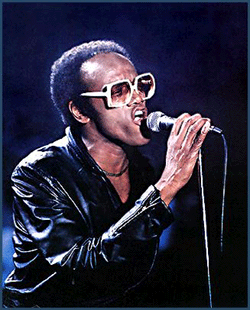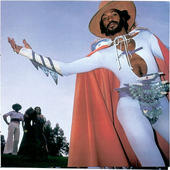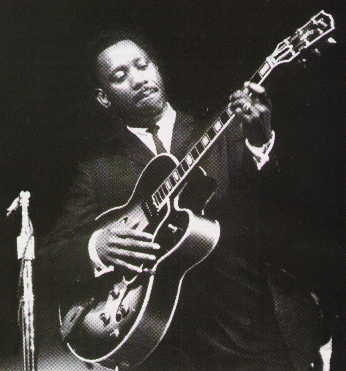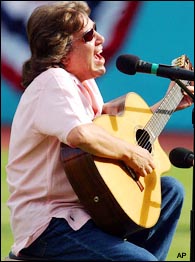EDDIE HAZEL / “California Dreamin’ ”
The exodus of black people post-Katrina was of such epic proportions that some have begun to refer to it as a new ‘Great Migration.’ While I can’t say whether or not the reference is accurate, I can say it’s early. One of the problems with attempting to compare the current mass movement of people with previous migrations is that, this time, the migration was immediate, unplanned and largely random. It’s going to take a long time to see how things play out. Will the folk who left the Gulf Coast area put down roots in their new locales or will they make their way back to the South? And, with the majority of blacks who left the Gulf Coast ending up only as far west as Houston, as far North as Memphis and as far east as Atlanta, does that really qualify as a ‘great’ migration?
The original ‘Great Migration’ is said to have begun in the early 1900s and continued for several decades as black Southerners went North in search of work and a better life. (Meaning, one without the constant threat of rape, lynching, false arrest and the like.) Large urban centers such as New York, Chicago, Cleveland and Detroit were the main destinations. A century later, blacks remain in all of those cities and in large numbers. The ‘Second Great Migration’ began in the 1950s and continued through the early 1970s, with large numbers of blacks again moving from the South, but this time the destination included points west, most commonly Los Angeles or Oakland, and the people moving tended to be, if not educated professionals, at least skilled laborers.
But the attempt to make conclusions about the actions of large groups of people—all of whom have individual motivations and problems—usually leads to exaggeration, distortion and vagary. The whole ‘Great Migration’ thing is no exception. Most sources synthesize the migrations in the way I just did, with the first one being to points north and the second one including the west. How do we explain then, that according to the 1910 census (and remember, that would be the early end of the first great migration) Los Angeles had the highest percentage of black home ownership in the country? Maybe it has something to do with the origins of L.A. Most don’t know it, but of the eleven Mexican families who founded Los Angeles, four were either black or mulatto. It seems to me that black folk have been ‘California Dreamin’ for a long, long time.
Today, blacks are firmly entrenched throughout the major metropolitan areas of California, but the historians are at it again. This time, it’s ‘Reverse Migration.’ Apparently, large numbers of young black professionals are leaving the same cities their parents and grandparents moved to decades earlier and for similar reasons. It’s still a better life people are after, only this time ‘a better life’ usually means a bigger car, a greener lawn and a less pricey real estate market. Even before Katrina, southern cities like Dallas, Raleigh-Durham, Memphis, Houston and, most of all, Atlanta were experiencing an influx of young educated blacks. Recent census figures bear this out. For most of the 1990s, the only area of the country that actually saw an increase in black population was the South. And, the most recent nationwide census (in 2000) tells us that the during the ‘90s, the black population of Los Angeles dropped for the first time ever.
The California Dream is still alive, but it’s shifted to a lighter shade of brown. If you want to talk about ‘great migrations,’ do a little research on the movement of people from South America and Central America to California, Arizona and Texas. In 1999, California became the first ‘minority majority’ state in the union. (Meaning, non-whites make up more the 50% of the population.) In most major cities of the state (including here in San Diego) freeway billboards, restaurant signs and television stations seem as likely to be in Spanish as English. In and around Los Angeles, historically-black areas like Watts and Compton are increasingly populated by Latinos. So far, middle-class and upper-class black areas like Baldwin Hills, Ladera Heights and Inglewood are holding strong, but the writing is on the wall. The ‘browning’ of California is in full swing and nothing’s going to stop it.
Just the other night, I watched a movie named ‘A Day Without A Mexican.’ (Not coincidentally, the film featured two versions of “California Dreamin’,” one in Spanish and the other in English.) It’s a satire about the day every Latino in California is simultaneously raptured, leaving the blacks, whites and Asians of the West Coast in a state of chaos and confusion. For me, the most interesting aspect of the movie was that blacks were presented identically to whites. I don’t know if that was a conscious decision made by the (Latino) writers and director of the film or if it just happened to be the way they see things. Either way, it makes a powerful statement: from the point of view of Latinos, black people are just like white people. According to the casting choices of the filmmakers, blacks are just as likely to be emergency room nurses, border patrol agents, politicians and news reporters as are whites. In other words, blacks are living the American dream. Maybe that’s the real reason young black folk are going back ‘home’ to the South. Maybe that’s the real reason that blacks, for the first time in American history, aren’t ‘California Dreamin.’ Maybe they don’t need to anymore.
Despite being covered repeatedly by black musicians, “California Dreamin’ ” isn’t exactly an R&B song. It started out as a pop/folk tune written by John and Michelle Phillips of The Mamas and The Papas. (For a great piece by NPR on the history of the original song, go here. “California Dreamin’ ” is usually thought of as “an anthem to homesickness” (which is the way NPR put it in their write-up) and I suppose that’s accurate. But when black folk sing the Phillips’ song, I hear a lot more than homesickness. Most telling are the ad libs, those moments common to most black music when the musicians deviate from the written script to let loose their emotions. Listen to the intensity of Lee Moses’ gravely voice when he screams, “Whoah! I got to get to L.A.! Where folks say the sun shines.”

Check out Bobby Womack: “Gotta get some sunshine before I blow my mind.”

Sometimes it’s not even words—former Funkadelic axe slinger Eddie Hazel goes on a minute-and-a-half-long blues guitar excursion before getting around to the actual song.
Listening to all these versions of “California Dreamin'” back-to-back, I hear undertones of what Otis Redding was singing about when he was sitting on the dock of the San Francisco bay. It’s not just homesickness that these musicians—either Otis or the others—are singing about, it’s also wasted dreams and lost time. It’s promises and hopes unfulfilled. It’s wishing for a better something somewhere that doesn’t actually exist anywhere…not even in California. It’s as if the “L.A.” in the song has become a metaphor for “a better place” while “sunshine” is a metaphor for hope and opportunity. Hell, anyone who’s spent significant time in L.A. can tell you that the place is a labyrinth of good, bad and everything in between. If you’re doing well for yourself, it’s a great place to be. If you’re not…well, it’s like doing bad anywhere else, I suppose. Bad is bad.

Then there’s the anachronistic Wes Montgomery version. I’m not sure what to make of that one. It’s so sprightly and upbeat, that you’d think dude recorded it with a winning lottery ticket in his back pocket. For a song ostensibly about gray skies and melancholy, Wes’ version is so bright that it’s hard to listen to it and feel anything but happy.

Another side of the California Dream is represented by the contemporary takes on the song. Tiombe Lockhart’s “California” starts off as a cover but then drifts into what sounds like a largely-improvised piano and vocal tangent. “It’s all OK,” she sings over and over. “It’s all OK.”

Queen Latifah is barely improvising at all—she sticks closely to the original lyric, but the overall tone is light and fluid. There’s a touch of melancholy, but no blues to speak of. For a lot of my generation—the post-Civil Rights babies—the cold reality of deferred and broken dreams is little more than stories told by our parents and our parents’ parents. I think the almost ambivalent nature of the more recent covers of “California Dreamin’ ” reflects the increasingly complex feelings black folk—especially those who are relatively young and successful—have about the archetypal American Dream. I don’t know that we’re any happier than previous generations were, but we’re certainly more comfortable.
Get your versions here:
Eddie Hazel – Game Dames And Guitar Thangs (Warner Bros, 1977)
Bobby Womack – Fly Me To The Moon (Minit, 1969)
Wes Montgomery – California Dreaming (Verve, 1966)
Queen Latifah – The Dana Owens Album (Interscope, 2004)
Tiombe Lockhart – The Tiombe Lockhart Bootleg #1 (White Label, 2003)
Lee Moses – Time & Place (Reissued on the Castle label, 2006; Originally released in 1971)
—Mtume ya Salaam
Hola Cali!
Well, well, well, Mtume, you sure are in a scholarly mood this week. It's almost like you got a night gig in the Sociology department at UCLA. ;-)
Reading the Cops peace back-to-back with this Migration/Cali piece could give one severe whip-lash. While I fully understand both pieces separately, I'm not quite sure of what to make of them together.

My most immediate response is Jose Feliciano! I like his soulful, bilingual version. Jose gets the Black elements down in spades and then he runs that Spanish stuff near the end, and says it doesn't make a difference how you say it.
Sooooo... are we still dreaming?
Connsider "California Dreamin'" as the follow-up to "I Have A Dream." Neither of them worked out. What's next?
—Kalamu ya Salaam
This entry was posted on Sunday, December 17th, 2006 at 12:51 am and is filed under Cover. You can follow any responses to this entry through the RSS 2.0 feed. You can leave a response, or trackback from your own site.
Leave a Reply
| top |